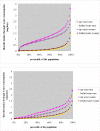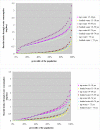Fluoride intake through consumption of tap water and bottled water in Belgium
- PMID: 19543414
- PMCID: PMC2697936
- DOI: 10.3390/ijerph6051676
Fluoride intake through consumption of tap water and bottled water in Belgium
Abstract
There is a tendency to align higher levels of fluoride in natural mineral water with the existing higher levels in tap water. Treatment of natural mineral waters could harm the preservation of their natural character. In this study fluoride intake through bottled and tap water consumption in the Belgian adult population was assessed, taking into account regional differences. A deterministic approach was used whereby consumption quantities of tap water and different brands of bottled water were linked with their respective fluoride concentrations. Data from the national food consumption survey (2004) were used and the Nusser methodology was applied to obtain usual intake estimates.Mean intake of fluoride through total water consumption in Flanders was 1.4+/-0.7 mg/day (97.5(th) percentile: 3.1 mg/day), while in the Walloon region it was on average 0.9+/-0.6 mg/day (97.5(th) percentile: 2.4 mg/day). The probability of exceeding the UL of 7 mg per day via a normal diet was estimated to be low. Consequently, there is no need to revise the existing norms, but higher fluoride concentrations should be more clearly indicated on the labels. Reliable data about total dietary fluoride intake in children, including intake of fluoride via tooth paste and food supplements, are needed.
Keywords: Belgium; exposure assessment; fluoride; food consumption survey.
Figures


References
-
- World Health Organization . Report of an Expert Committee on Oral Health Status and Fluoride Use. Fluorides and Oral Health. WHO Technical Report Series No 846. WHO; Geneva, Switzerland: 1994. - PubMed
-
- Hodge HC, Smith FA. Occupational fluoride exposure. J. Occup. Environ. Med. 1977;19:12–39. - PubMed
-
- Caraccio T, Greensher J, Mofenson HC. The toxicology of fluoride. In: Haddad L, Winchester J, editors. Clinical Management of Poisoning and Drug Overdose. 2nd Ed. WB Saunders Philadelphia; Pennsylvania, USA; 1983.
-
- Ekstrand J, Spak CJ, Ehrnebo M. Renal clearance of fluoride in a steady state condition in man: influence of urinary flow and pH changes by diet. Acta Pharmacol. Toxicol. 1982;50:321–325. - PubMed
-
- Groeneveld A, van Eck AA, Backer Dirks O. Fluoride in caries prevention: is the effect preor post-eruptive? J. Dent. Res. 1990;69:751–755. - PubMed
Publication types
MeSH terms
Substances
LinkOut - more resources
Full Text Sources
Miscellaneous

